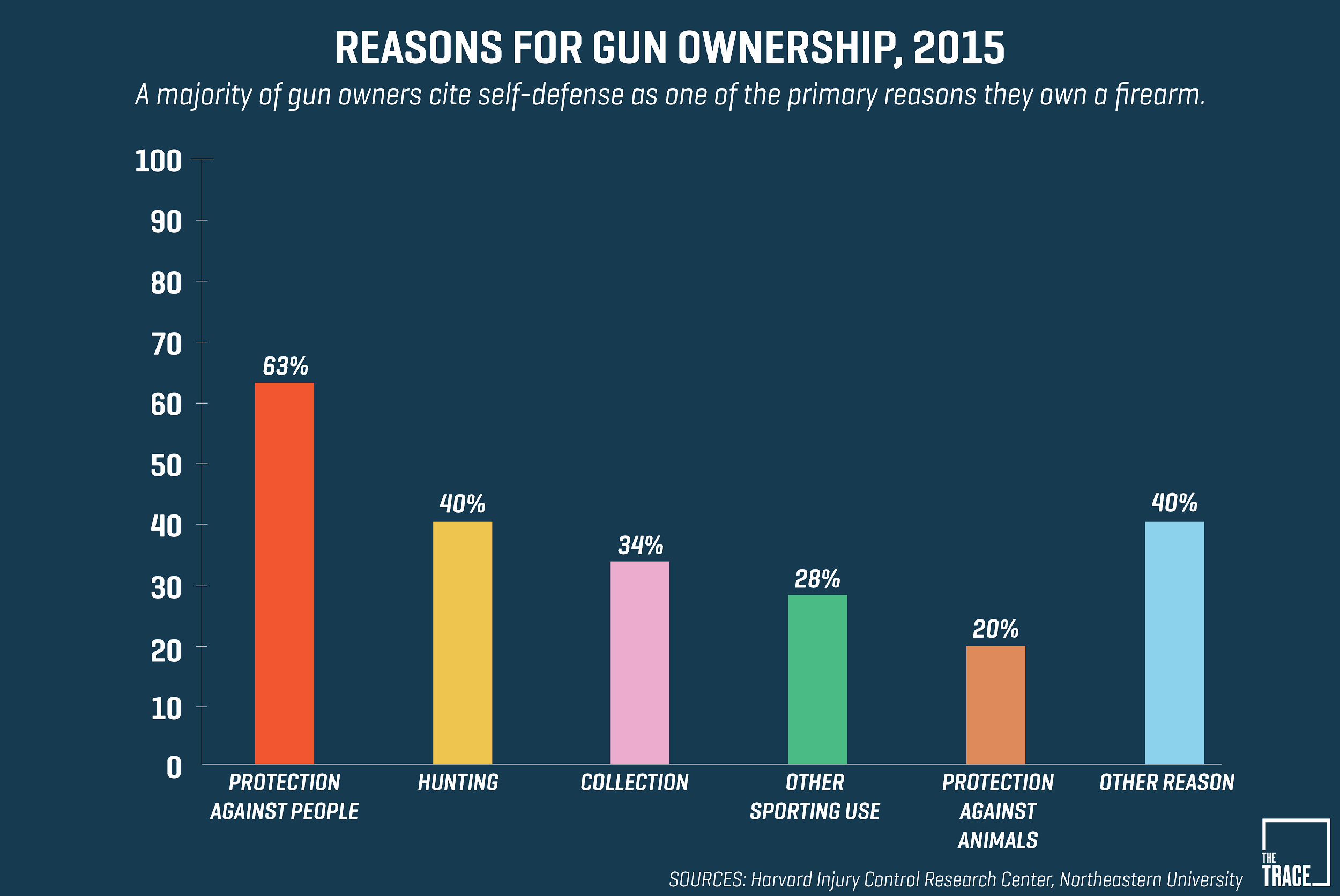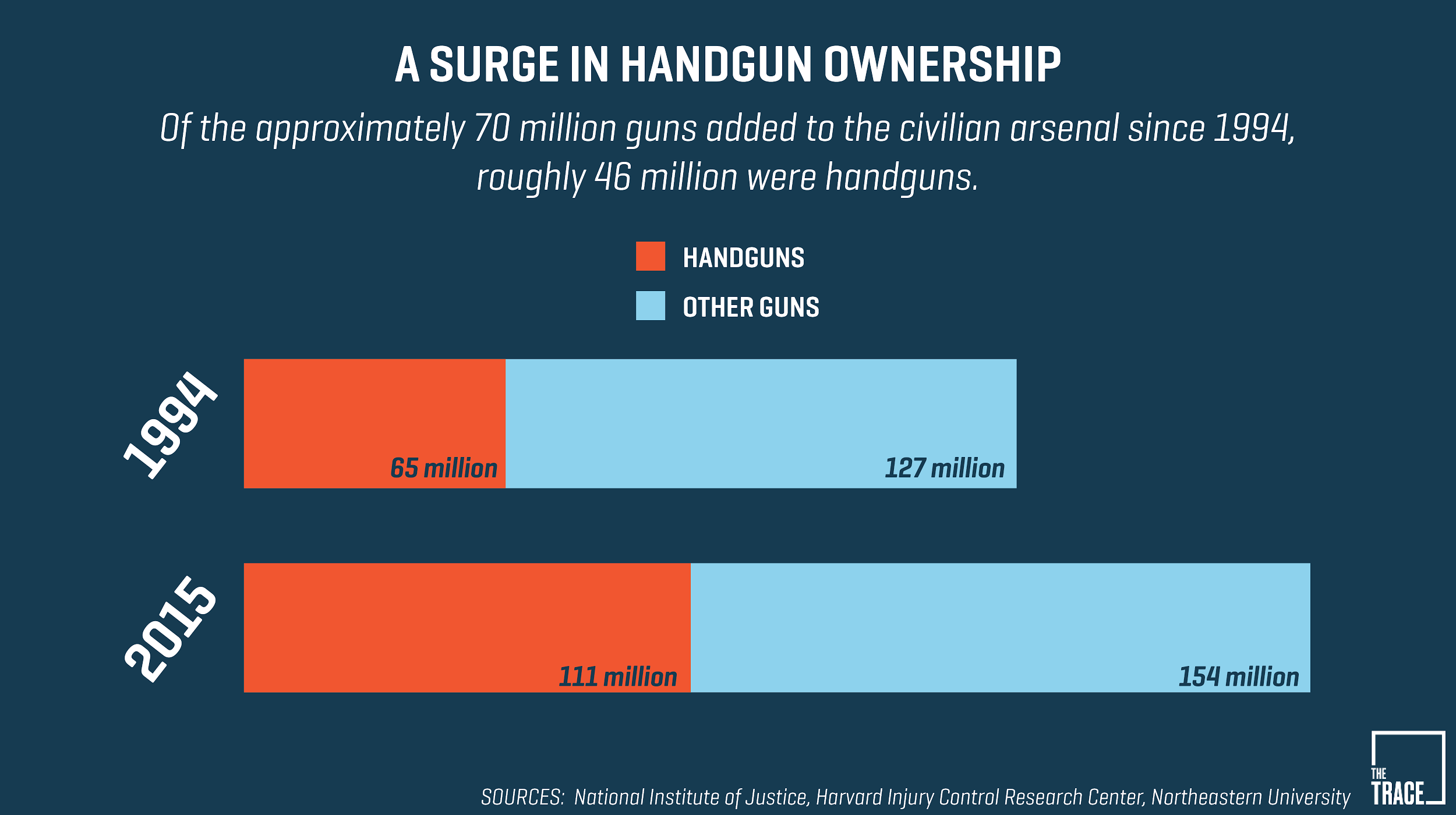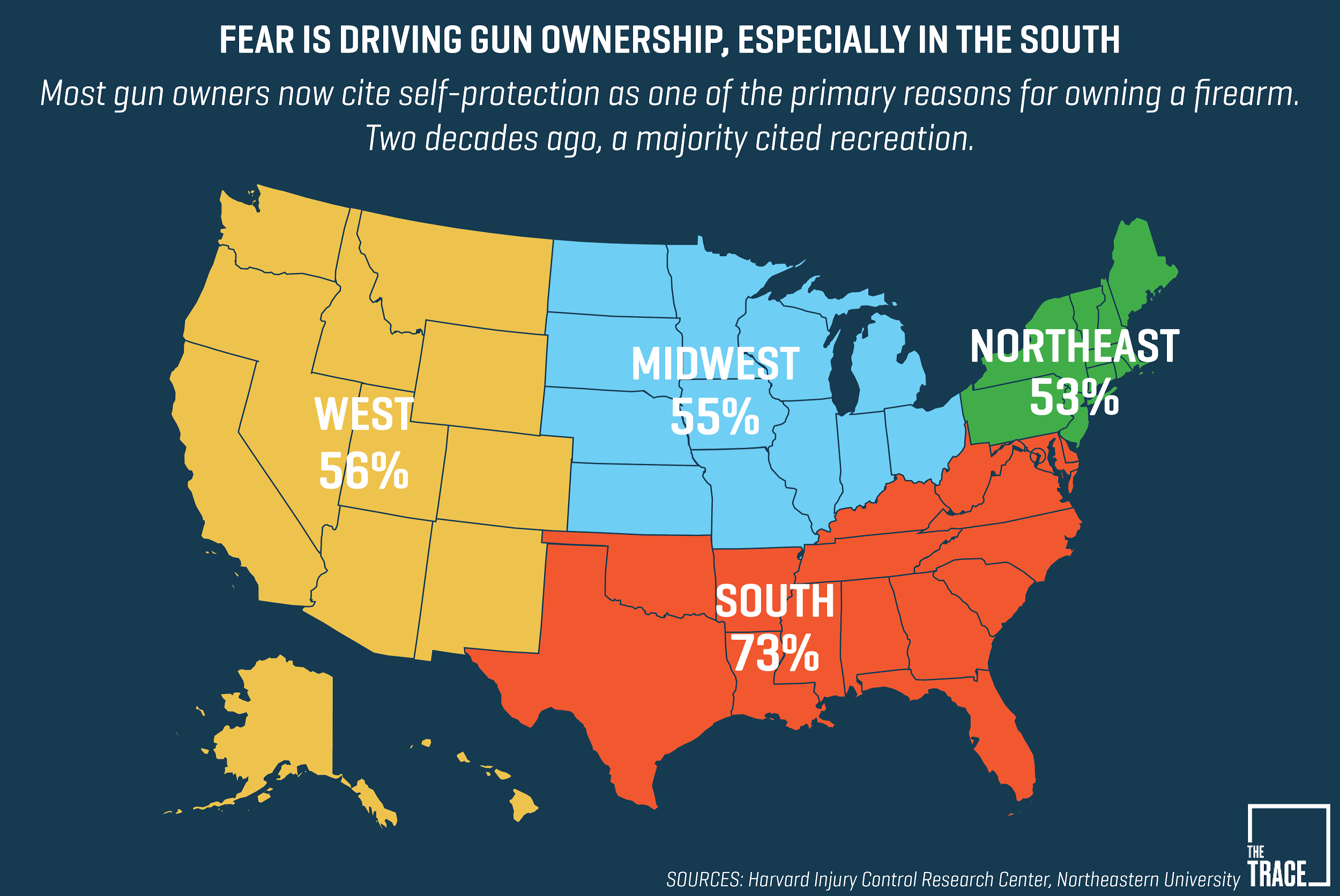Amid a historic plunge in the national violent crime rate, more Americans than ever are arming themselves to protect against attack by other people, a new survey of U.S. gun ownership by researchers at Harvard and Northeastern universities reveals. Their weapon of choice is a handgun, which is portable and easily concealable, and in many states, can be carried in an increasing number of public places.
Pistols, revolvers, and other handguns account for a majority of the estimated 70 million new firearms added to the nation’s gun stock in the past two decades.
The survey, which researchers characterize as the most authoritative since 1994, calculates that there are an estimated 265 million firearms in U.S. homes — more than the number of cars on American roads. The Trace and The Guardian were provided an advance summary of the survey’s major findings, set for publication by the Russell Sage Foundation next year.
While long guns, like rifles and shotguns, still account for a majority of privately-owned weapons, civilian gun owners have acquired 40 to 50 million handguns since 1994.
Eighty percent of gun owners keep at least one handgun. Two out of three say that self-defense is a primary motivation for owning a firearm, researchers found.
Even though homicides and other forms of violent crime have dramatically decreased, a rise in the number of high-profile rampage shootings has heightened perceptions of danger, and helped fuel the handgun-buying boom. At the same time, the gun lobby has aggressively campaigned to lift restrictions against carrying firearms in public and stoked fears of government gun seizures. The firearms industry and retailers have also amped up their marketing of handguns for self-defense purposes.
“When I look at our survey, what I see is a population that is living in fear,” says Deb Azrael, a researcher at the Harvard School of Public Health and one of the lead authors of the study. “They are buying handguns to protect themselves against bad guys, they store their guns ready-to-use because of bad guys, and they believe that their guns make them safer.”

The number of civilian gun owners has grown alongside the U.S. gun stock. In 2015, there were approximately 55 million gun owners, compared with approximately 44 million in 1994. But because of population increases, the share of Americans who own guns over the same period dipped slightly, from 25 percent to 22 percent.
The survey findings illustrate a sharp cultural shift in American gun ownership patterns. As recently as two decades ago, the last time a survey of this magnitude and accuracy was conducted, the primary reason people cited for keeping guns at home was for recreation, which includes hunting or sports shooting.
Gun violence researchers say the rise in handgun ownership has public health consequences.
Studies have found that people who live in homes with handguns are twice as likely to take their life compared to those who live in homes with other types of firearms, such as shotguns and rifles. (Seniors are the population at the highest risk of using a handgun in a fatal suicide attempt.)
Domestic violence victims are five times more likely to be killed if their abuser has access to a gun, research shows.
The Harvard/Northeastern survey shows a slight increase in the number of gun-owning women — a group that now makes up 12 percent of all gun owners. But while nearly 70 percent of women cited self protection as one of the primary motivations for owning a gun, past studies show that a gun in the home is statistically more likely to be used to harm a woman than to help one.
“Our survey suggests that many more people believe guns in their home make them safer, when in fact, epidemiological research suggests precisely the opposite,” Azrael says.
One consequence of more small and portable guns, taken to more public places, is an increased threat of theft. The new survey estimates that hundreds of thousands of guns are stolen in the U.S. each year. Many flood the illegal market.
Independent estimates of the gun stock and the characteristics of the gun-owning population are important because there is no government agency that records or monitors civilian ownership in the U.S. The Bureau of Alcohol, Tobacco, Firearms, and Explosives collects yearly data on the number of firearms manufactured and exported, but it doesn’t count guns that are already in circulation, and it doesn’t survey owners to understand their motivations, fears, and habits.
The Centers for Disease Control and Prevention, which studies other health epidemics, conducts very little gun research, owing to 1996 legislation that is widely interpreted as preventing it.
The last comprehensive examination of American gun ownership came in 1994, when the National Institute of Justice funded a similar survey to the one slated for release next year. (In 2004, the same group of Harvard and Northeastern researchers conducted a survey of the gun stock, but caution against using it for comparisons. In that survey, a telephone poll was used to collect results — a method that many researchers, including Azrael, say gave inaccurate results due the declining popularity of landlines.)
The new survey polled nearly 4,000 U.S. adults on their gun buying and ownership habits. The Trace and The Guardian will publish stories based on the survey throughout this week. Here are its key findings:
Roughly 3 percent of American adults own half of the country’s civilian guns.
While the percentage of Americans who own guns has stayed relatively constant, their arsenals are bigger than ever before.
The average number of guns in a home has increased from approximately four to five, the findings show. Roughly 8 percent of gun owners own 10 or more guns. The combined arms of 14 percent of gun owners — or roughly three percent of all American adults — account for half of all civilian-owned firearms in the county.
Americans are buying more handguns than other types of firearms.
Roughly half of respondents said they had acquired their most recent firearm in the last five years, either through a purchase, transfer, or gift. The researchers estimate there were 70 million gun transfers in the last five years (this figure includes firearms that are already in circulation). In other words, Americans bought and transferred roughly one-fourth of the total gun stock in the last five years.
Handguns accounted for almost six out of 10 guns acquired in this period.

Most of those weapons were semiautomatic pistols. In 2013, the most recent year for which ATF manufacturing data is available, domestic gunmakers produced more than 4.4 million pistols, a huge leap from a decade earlier.
Americans still buy millions of long guns, though. There were a record 3.9 million rifles manufactured in 2013.
Handgun purchases are largely driven by concerns for safety and a desire for self-defense.
Sixty-three percent of all gun owners say one of the primary reasons they own a firearm is for protection against people, while only 46 percent cited protection as the principal reason for gun ownership in 1994. But in both 1994 and 2015, roughly 75 percent of handgun-only owners reported that they kept a gun primarily for self protection. In comparison, only 31 percent of long gun-only owners cite protection against strangers as a primary reason for owning a gun.

The defensive mindset is especially pronounced in some regions of the country: Almost three-quarters of Southern gun owners said they own their firearms for self-protection.
The identity of the handgun owner is evolving.
The survey finds that, like the majority of gun owners, those who own handguns are mostly white males, 30 years of age or older, with a high school education or some college. But those that own just handguns — and not a long gun, like a shotgun or rifle — are more likely than the typical owner to be female, non-white, and live in an urban setting. They are also less likely to have grown up in a house with a gun.
Forty-three percent of respondents who said they only owned a handgun were women.
Dozens of guns are stolen from private citizens every hour.
Researchers estimate that between 300,000 and 600,000 guns stolen are stolen from private owners each year.
At the high end of the estimate, that would add up to 1,600 guns stolen every day, more than one every minute — enough firearms to provide a weapon for every instance of gun violence in the country each year.
[Featured image: Michael Murphy, “Identity Crisis.”]

